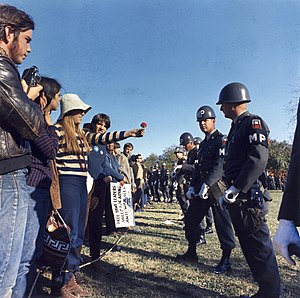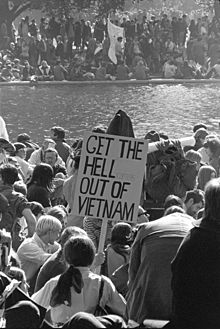National Mobilization Committee to End the War in Vietnam
| National Mobilization Committee to End the War in Vietnam | |||
|---|---|---|---|
| Part of Opposition to United States involvement in the Vietnam War, and the Poor People's Campaign | |||
 | |||
| Date | October 21, 1967 | ||
| Location | Washington, D.C. | ||
| Parties to the civil conflict | |||
| |||
| Lead figures | |||
| |||
The Spring Mobilization Committee to End the War in Vietnam, which became the National Mobilization Committee to End the War in Vietnam, was a coalition of antiwar activists formed in 1967 to organize large demonstrations in opposition to the Vietnam War. The organization was informally known as "the Mobe".
Contents
1 April 15, 1967 Anti-Vietnam war demonstrations
2 1967 "March on the Pentagon"
3 1968 Chicago Democratic National Convention Demonstrations
4 Further activity
5 See also
6 Media
7 References
8 External sources
April 15, 1967 Anti-Vietnam war demonstrations
On April 15, 1967, the Spring Mobilization's massive march against the Vietnam War from Central Park to the United Nations attracted hundreds of thousands of people, including Dr. Martin Luther King, Jr., Harry Belafonte, James Bevel, and Dr. Benjamin Spock, who marched and spoke at the event. During the event many draft cards were burned, according to the New York Times.[1] A simultaneous march in San Francisco was attended by Coretta Scott King.
At the New York march its last speaker, James Bevel, the Spring Mobilization's chairman and initiator of the march on the U.N. (until Bevel came aboard at the invitation of A. J. Muste and David Dellinger the plan was for just an April 15 rally in Central Park), made an impromptu announcement that the next major anti-war gathering would be in Washington D.C.[2]
Bevel's announcement brought about the Spring Mobilization Conference, a gathering of 700 antiwar activists held in Washington D.C. May 20–21, 1967, called to evaluate April's massive antiwar demonstrations. It was organized to chart a future course for the antiwar movement, and set another large antiwar action for the fall of 1967 and created an administrative committee - the National Mobilization Committee to End the War in Vietnam - to plan it.
1967 "March on the Pentagon"

Vietnam War protestors at the 1967 "March on the Pentagon".
The Mobe then planned and organized a large demonstration for Washington D.C. on October 21, 1967. This demonstration was a rally at West Potomac Park near the Lincoln Memorial and a march to the Pentagon, where another rally would be held in a parking lot, followed by civil disobedience on the steps of the Pentagon itself. The action was known as the "March on the Pentagon."
Hoping to attract young, educated college students, Mobe coordinator David Dellinger appointed Jerry Rubin, who led the large Vietnam Day Committee at the University of California, Berkeley,[3] to organize the march.[3] The initial D.C. rally, which was galvanized by a concert performance from counterculture folk singer Phil Ochs,[4] drew approximately 70,000 participants at the Lincoln Memorial.[5] Following Ochs' concert, as well as speeches from Dellinger and Dr. Spock,[6] around 50,000 of those attending were then led by social activist Abbie Hoffman and marched from the Lincoln Memorial to The Pentagon in nearby Arlington, Virginia to participate in a second rally.[3]
About 650 people, including novelist Norman Mailer, were arrested for civil disobedience on the steps of the Pentagon. A few individuals such as Allen Ginsberg, Ed Sanders, Abbie Hoffman and Jerry Rubin (Hoffman and Rubin would co-found the Yippies later in '67) attempted by means of meditation and chanting to "levitate" the building and "exorcise the evil within." These events were chronicled by Norman Mailer in his non-fiction novel The Armies of the Night.
1968 Chicago Democratic National Convention Demonstrations
Following the Pentagon demonstration, the Mobe began discussion and planning for demonstrations at the 1968 Democratic National Convention, to be held in Chicago, where President Lyndon B. Johnson was expected to be nominated for a second term.
Tom Hayden and Rennie Davis were the key Mobe organizers for the Chicago demonstration, and would later be indicted for conspiracy and inciting a riot as members of the Chicago Seven.[citation needed] The Chicago demonstrations drew only 10,000 participants because it was widely anticipated that the mayor of Chicago, Richard J. Daley, would deploy his police to prevent marches to the site of the Convention.
Norman Mailer wrote a non-fiction novel about both the 1968 Democratic and Republican Conventions entitled Miami and the Siege of Chicago.
Further activity
Following the election of Richard M. Nixon, the Mobe organized a "counter-inaugural" to take place in Washington D.C. on the day of Nixon's inauguration. This demonstration also attracted about 10,000 people and was accompanied by street violence.
The National Mobilization Committee to End the War in Vietnam then disbanded.
Future national marches against the Vietnam war would be organized by other groups. The similarly named and inspired New Mobilization Committee to End the War in Vietnam (New Mobe) was founded at a conference at Case Western Reserve University in July 1969, and, together with the Vietnam Moratorium Committee and the Student Mobilization Committee (SMC), organized the October 15, 1969 Moratorium to End the War in Vietnam which resulted in large demonstrations against the Vietnam War held nationwide.[7] The groups then organized another large demonstration in Washington D.C. to occur a month later, on November 15, 1969, which was also attend by a large crowd.
Individuals and organizations associated either with the Spring Mobilization to End the War in Vietnam or the National Mobilization Committee to End the War in Vietnam include Dr. Benjamin Spock and SANE, Sidney Peck, Eric Weinberger, David Dellinger, Jerry Rubin, James Bevel, Stew Albert, A. J. Muste, Dr. Martin Luther King, Jr., Coretta Scott King, Rennie Davis, Karen Wald, Fred Halstead, Bradford Lyttle, Charles Owen Rice, Vietnam Summer, Cornell Professor Robert Greenblatt (who became national coordinator of the Mobilization to End the War),[8] and Tom Hayden.
See also
Flower Power (photograph)- The Ultimate Confrontation: The Flower and the Bayonet
- List of peace activists
- List of anti-war organizations
Media
The Armies of the Night (book by Norman Mailer)
Miami and the Siege of Chicago (book by Norman Mailer)
References
^ "Many Draft Cards Burned - Eggs Tossed at Parade." New York Times, April 16, 1967, p. 1,38
^ "James L. Bevel The Strategist of the 1960s Civil Rights Movement" by Randall Kryn, a paper in David Garrow's 1989 book We Shall Overcome, Volume II, Carlson Publishing Company
^ abc Levitate the Pentagon
^ Peter Braunstein (2004). The Sixties Chronicle. Legacy Publishing. p. 16. ISBN 141271009X..mw-parser-output cite.citationfont-style:inherit.mw-parser-output .citation qquotes:"""""""'""'".mw-parser-output .citation .cs1-lock-free abackground:url("//upload.wikimedia.org/wikipedia/commons/thumb/6/65/Lock-green.svg/9px-Lock-green.svg.png")no-repeat;background-position:right .1em center.mw-parser-output .citation .cs1-lock-limited a,.mw-parser-output .citation .cs1-lock-registration abackground:url("//upload.wikimedia.org/wikipedia/commons/thumb/d/d6/Lock-gray-alt-2.svg/9px-Lock-gray-alt-2.svg.png")no-repeat;background-position:right .1em center.mw-parser-output .citation .cs1-lock-subscription abackground:url("//upload.wikimedia.org/wikipedia/commons/thumb/a/aa/Lock-red-alt-2.svg/9px-Lock-red-alt-2.svg.png")no-repeat;background-position:right .1em center.mw-parser-output .cs1-subscription,.mw-parser-output .cs1-registrationcolor:#555.mw-parser-output .cs1-subscription span,.mw-parser-output .cs1-registration spanborder-bottom:1px dotted;cursor:help.mw-parser-output .cs1-ws-icon abackground:url("//upload.wikimedia.org/wikipedia/commons/thumb/4/4c/Wikisource-logo.svg/12px-Wikisource-logo.svg.png")no-repeat;background-position:right .1em center.mw-parser-output code.cs1-codecolor:inherit;background:inherit;border:inherit;padding:inherit.mw-parser-output .cs1-hidden-errordisplay:none;font-size:100%.mw-parser-output .cs1-visible-errorfont-size:100%.mw-parser-output .cs1-maintdisplay:none;color:#33aa33;margin-left:0.3em.mw-parser-output .cs1-subscription,.mw-parser-output .cs1-registration,.mw-parser-output .cs1-formatfont-size:95%.mw-parser-output .cs1-kern-left,.mw-parser-output .cs1-kern-wl-leftpadding-left:0.2em.mw-parser-output .cs1-kern-right,.mw-parser-output .cs1-kern-wl-rightpadding-right:0.2em
^ "The March on the Pentagon". Harvard Crimson. October 24, 1967. Retrieved July 7, 2014.
^ The Day The Pentagon Was Supposed To Lift Off Into Space Archived 2005-12-19 at the Wayback Machine
^ Newsweek Magazine, October 27, 1969
^ Glenn C. Altschuler, Isaac Kramnick (2014). Cornell: A History, 1940–2015. Cornell University Press. ISBN 0801471885.CS1 maint: Uses authors parameter (link)
External sources
- Walking tour of New York entry
